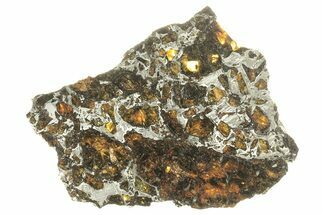1.47" Polished Admire Pallasite Meteorite (6.75 g) Slice - Kansas
This 1.47" wide (6.75 gram) sliced and polished piece of pallasite meteorite comes from the unobserved Admire meteor fall. The thin slicing of the pallasite beautifully highlights the olivine (forsterite) crystals' translucency when backlit.
The thin slicing of this meteorite makes it relatively fragile. Please be careful when removing the specimen from packaging.
The thin slicing of this meteorite makes it relatively fragile. Please be careful when removing the specimen from packaging.
About The Admire Pallasite
The first documented pieces of this meteorite were collected in 1881 by a farmer plowing his field near the city of Admire in Lyon County, Kansas. Its fall was not observed. More than a century later, meteorite hunters returned to the site and discovered more pieces. As of today, over 2 tons have been recovered.
It is classified as a PMG (main group) pallasite, of which the major mineral assemblages consist of troilite, schreibersite, olivine (forsterite), kamacite, and taenite. Its olivine crystals still display beautiful translucence when the pallasite is cut thin, but take on much more angular shapes than olivines in other pallasites.
The first documented pieces of this meteorite were collected in 1881 by a farmer plowing his field near the city of Admire in Lyon County, Kansas. Its fall was not observed. More than a century later, meteorite hunters returned to the site and discovered more pieces. As of today, over 2 tons have been recovered.
It is classified as a PMG (main group) pallasite, of which the major mineral assemblages consist of troilite, schreibersite, olivine (forsterite), kamacite, and taenite. Its olivine crystals still display beautiful translucence when the pallasite is cut thin, but take on much more angular shapes than olivines in other pallasites.
About Pallasites
Pallasite meteorites are a class of stony-iron meteorites. They were once believed to have originated at the core-mantle boundary of asteroids that shattered through impacts, but a recent hypothesis is that they are a mixture of core and mantle minerals.
Pallasite meteorites consist of olivine (peridot) crystals surrounded by iron-nickel matrix. Upon acid etching, some pallasites display interweaving structures known as Widmanstätten patterns (or Thomson lines) in the metallic matrix. These structures are iron-nickel alloy crystals, typically kamacite and taenite, that cooled over millions of years in the vacuum of space.
Pallasites are quite rare: only about 200 are known, and only four have had observed falls. This represents less than 0.2% of all classified meteorites!
Pallasite Care
Pallasites are even more susceptible than most iron meteorites to rusting and deterioration due to moisture in the atmosphere; proper care includes keeping them in moisture-free environments. This is particularly important in areas with high humidity, such as Florida. All pallasite material we sell has been stabilized in some way, which will help with this issue, but care still needs to be taken to keep your treasure in good condition. Keep pallasites stored in a moisture-free environment, preferably with a corrosion inhibitor such as silica gel beads or a dehumidifier.
Pallasite meteorites are a class of stony-iron meteorites. They were once believed to have originated at the core-mantle boundary of asteroids that shattered through impacts, but a recent hypothesis is that they are a mixture of core and mantle minerals.
Pallasite meteorites consist of olivine (peridot) crystals surrounded by iron-nickel matrix. Upon acid etching, some pallasites display interweaving structures known as Widmanstätten patterns (or Thomson lines) in the metallic matrix. These structures are iron-nickel alloy crystals, typically kamacite and taenite, that cooled over millions of years in the vacuum of space.
Pallasites are quite rare: only about 200 are known, and only four have had observed falls. This represents less than 0.2% of all classified meteorites!
Pallasite Care
Pallasites are even more susceptible than most iron meteorites to rusting and deterioration due to moisture in the atmosphere; proper care includes keeping them in moisture-free environments. This is particularly important in areas with high humidity, such as Florida. All pallasite material we sell has been stabilized in some way, which will help with this issue, but care still needs to be taken to keep your treasure in good condition. Keep pallasites stored in a moisture-free environment, preferably with a corrosion inhibitor such as silica gel beads or a dehumidifier.
TYPE
Pallasite (PMG)
LOCATION
Admire, Lyon County, Kansas
SIZE
1.47 x .92", .08" thick, Weight: 6.75 grams
CATEGORY
SUB CATEGORY
ITEM
#307356
 Reviews
Reviews









